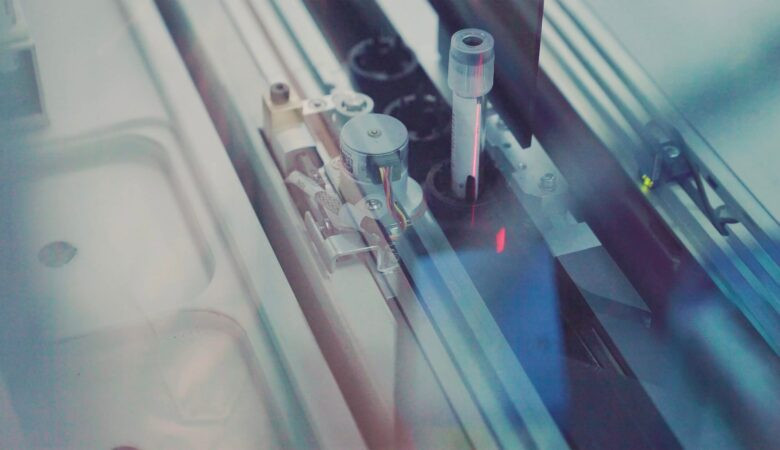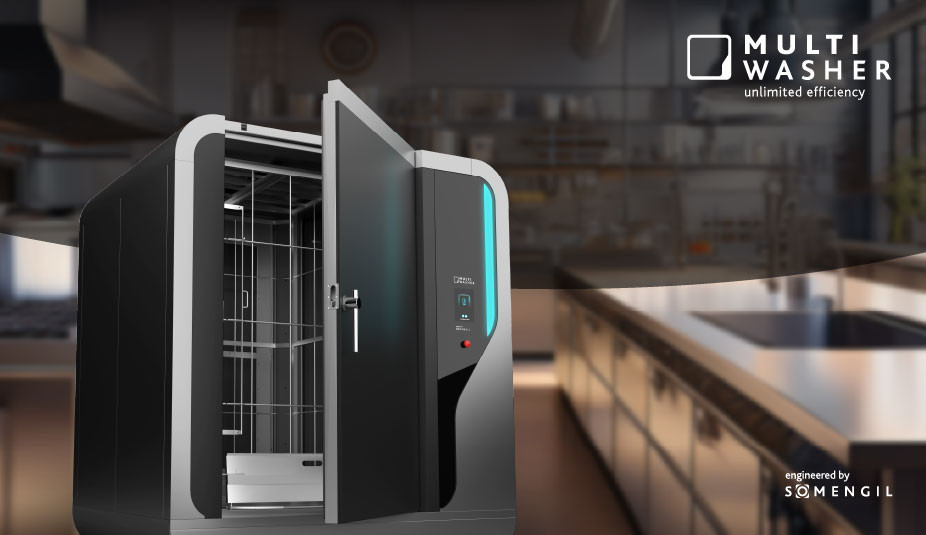Lavage industriel / Articles
L’automatisation industrielle : comment augmenter l’efficacité des opérations
Toutes les entreprises ont pour objectif d’optimiser les ressources. L’automatisation industrielle, ainsi que l’Internet of Things (IoT) sont des éléments-clé pour accroître l’efficacité des processus, notamment le lavage. Découvrez comment y parvenir

 17 minutes de lecture
17 minutes de lecture
2022-08-25 10:00:00
L’automatisation industrielle est utilisée par des entreprises du monde entier afin d’accroître l’efficacité de leurs processus et de réduire au maximum l’effort humain dans la chaîne de valeur. Découvrez comment cette tendance révolutionne les locaux de travail, en augmentant la productivité, l’efficacité et la rentabilité – et comment les entreprises, de toutes tailles et secteurs, peuvent en bénéficier.
Qu’est-ce que l’automatisation industrielle ?
L’automatisation industrielle consiste tout simplement à utiliser des technologiques et des mécanismes capables d’exécuter des tâches mécaniques répétitives, afin de réduire l’intervention humaine et d’augmenter l’efficacité et la compétitivité de l’entreprise.
Le champ d’action actuel de l’automatisation industrielle est vaste : il peut inclure des tâches sur les lignes de production ou de montage, des processus administratifs ou encore de transport et de manipulation de matériaux. Cette diversité est le fruit d’une évolution au fil de plusieurs décennies. L’un des modes d’automatisation les plus populaires – et anciens – est l’automatisation robotique, qui s’est affirmée dans la communication sociale et dans la culture populaire quasiment depuis sa naissance, dans les années 40. C’est précisément à cette époque-là qu’elle a gagné son surnom de « robotique », qui lui a été donné non pas par des ingénieurs ou des programmateurs, mais par un écrivain. Isaac Asimov, auteur de plusieurs œuvres de science-fiction, a employé le mot pour la première fois en 1942 dans l’un de ses romans. Asimov avait une opinion favorable quant au rôle des robots dans la société humaine, les décrivant comme des serfs utiles à l’Homme, qui allaient aider l’être humain à atteindre son potentiel. C’est également Asimov qui a proposé les trois « Lois de la robotique », qui allaient inspirer d’innombrables personnages de science-fiction de nombreuses autres histoires. Mais même pour un optimiste comme Asimov, il aurait été difficile d’imaginer que, 80 ans plus tard, il existerait près de 3 millions de robots actifs dans le monde entier, dans un contexte industriel.
Bien que la robotique soit l’une des formes d’automatisation les plus prisées, elle n’est pas la seule. La CAM (Computer Aided Manufacturing) est une technologie qui existe depuis de nombreuses années et qui permet la création de machines virtuelles destinées à contrôler et automatiser tout un processus de fabrication. Elle utilise une interface de design (CAD) sur ordinateur pour créer un modèle 3D de la pièce à fabriquer et ainsi générer le code nécessaire à son exécution.
L’automatisation industrielle est déjà également arrivée au numérique. L’une des solutions d’automatisation les plus prometteuses s’intitule RPA ou Robotic Process Automation. Il s’agit d’une technologie de logiciel qui facilite la construction, la mise en œuvre la gestion de programmes simulant les actions humaines et interagissant avec des systèmes numériques et des logiciels. Ce domaine a développé d’autres formes d’automatisation industrielle, tel que l’OCR ou Reconnaissance Optique de Caractères, qui accélère les processus administratifs et d’introduction de données. Le procédé OCR est capable de lire et de convertir automatiquement des images numérisées sur un texte en un format éditable par une machine. Cela permet aux entreprises d’automatiser le processus de saisie de données à partir de documents papier tels que des factures, dans leurs systèmes électroniques.
L’Internet of Things (IoT) est une autre des tendances les plus innovantes, qui permet de connecter des dispositifs par le biais de capteurs, logiciels d’automatisation et d’équipements de communication nécessaires à la transmission d’informations. Il est ainsi possible de prendre des décisions d’une manière plus efficace, par exemple pour détecter des failles et assurer une assistance et une maintenance plus rapide et efficace.
Avec tous ces milieux en expansion, il n’est pas étonnant que les prévisions soient encourageantes pour le marché de l’automatisation industrielle. Certaines estimations visent, d’ici 2027, les 274.61 milliards d’euros– une croissance à deux chiffres, en dépit de la pandémie. Les avantages se font sentir pour toutes les entreprises, quel que soit leur dimension ou leur secteur d’activité.
Quels sont les bénéfices et les risques de l’automatisation industrielle ?
Les entreprises bénéficient de divers avantages à mettre en œuvre l’automatisation industrielle, parmi lesquels la réduction du coût d’exploitation, l’augmentation de la capacité de production et des délais de livraison raccourcis. D’autre part, de hauts niveaux d’automatisation sont associés à un environnement de travail plus sûr pour les salariés et à une diminution de l’empreinte écologique. La libération du travail répétitif, dangereux et désagréable apportée par l’automatisation industrielle génère de nouvelles opportunités d’avenir. Les entreprises peuvent bénéficier d’un standard de travail et de vie plus élevé et allouer plus de ressources humaines au service de la croissance et l’expansion des affaires.
Des secteurs tels que l’alimentaire ou le commerce de détail sont ceux qui bénéficient le plus de l’optimisation de ce système d’automatisation des processus de production et de lavage. Étant donnée l’échelle quotidienne de travail, une réponse effective n’est possible que grâce à des stratégies d’automatisation industrielle pensées pour ces secteurs professionnels.
Cependant, l’automatisation industrielle représente également certains défis, le principal étant que l’automatisation industrielle peut entraîner un coût élevé de capital. Il est donc important d’évaluer le retour de l’investissement à moyen ou long terme, le coût pouvant être récupéré. Un autre défi est la flexibilité – un investissement élevé dans une solution technologique ne doit pas empêcher l’entreprise de s’adapter aux évolutions du marché aux nouveaux processus, produits ou services.
Dans le domaine du lavage d’ustensiles, l’automatisation industrielle peut être observée sur une nouvelle génération d’appareils. La MultiWasher, la machine à laver de Somengil, est un excellent exemple d’automatisation industrielle appliquée de manière pratique aux besoins des entreprises. D’une part, elle adapte les principales variables de lavage (température, pression, quantité de produit nettoyant) au type de produit à laver, automatiquement, à chaque cycle de lavage. Elle permet d’enregistrer jusqu’à 20 programmes de lavage sur un écran touch screen intuitif, afin de permettre à l’opérateur d’accéder rapidement à ce qu’il recherche au lieu de configurer manuellement les paramètres de lavage.
S’agissant d’un appareil ergonomique en cabine close, c’est la machine qui s’adapte aux processus – et non le contraire –, ce qui lui permet de fonctionner facilement à tout standard de travail. Le résultat est une amélioration des processus et la réduction de plus de 50 % de la consommation d’eau et d’énergie pendant le lavage.
Comment mettre en place l’automatisation industrielle dans le lavage
Il existe de nombreuses manières d’atteindre des niveaux élevés d’automatisation industrielle dans le processus de lavage. Voici les principales.
Des programmes de lavage préconfigurés
La possibilité de préconfigurer le lavage représente un avantage considérable, dans la mesure où elle ne requiert qu’une action initiale de l’opérateur pour que tous les processus se déroulent en adéquation avec le matériel à laver. La nécessité d’évaluer, lavage après lavage, le type de programme est donc éliminé, sans risque d’erreur ou de gaspillage d’eau, de produit nettoyant et d’énergie.
Les machines à laver de Somengil, on l’a déjà vu, proposent une grande variété de programmes disponibles, sur un écran tactile facile à utiliser. Il est ainsi possible d’associer, à chaque programme, un type d’ustensile et même une image afin de rendre le processus plus intuitif.
Par exemple, il est possible d’allouer le programme nº 1 aux bacs en plastique, le programme nº 2 aux chariots, etc., afin de faciliter le travail. Ou personnaliser chaque programme de lavage de la manière la mieux adaptée à son opération. Les principales variables de lavage sont ainsi mémorisées, dans le but de garantir des cycles optimisés.
Chargement et déchargement
L’un des processus manuels les plus longs pour le lavage d’ustensiles industriels est le chargement et le déchargement des chariots, qui implique habituellement des temps d’attente élevés. Il existe donc un laps considérable de temps non rentabilisé, outre le risque d’accidents ou de dommages sur les ustensiles associé à la manipulation humaine.
C’est la raison pour laquelle, chez Somengil, nous avons conçu des solutions personnalisées de chargement et déchargement des chariots, permettant ainsi de réduire les temps d’attente et d’automatiser le processus.
Les ustensiles sont placés avec facilité dans un chariot spécialement conçu à cette fin, se déplaçant facilement et rapidement à l’intérieur de la machine. L’opérateur sélectionne ensuite le programme spécifique pour le lavage et, une fois celui-ci terminé, l’opérateur n’a qu’à retirer le chariot portant les ustensiles propres, secs et désinfectés. En dépit de l’intervention de l’opérateur nécessaire, le processus est optimisé et simplifié au niveau de l’automatisation par l’esprit humain.
Réglage des paramètres de lavage automatiques
L’un des défis du lavage industriel manuel consiste à pouvoir laver des ustensiles très différents dans un même appareil. Certaines entreprises doivent souvent attendre d’avoir rassemblé une certaine quantité d’ustensiles pour mettre en route le lavage, entraînant ainsi des retards au niveau du flux de travail.
Afin de garantir un lavage efficace sans compromettre la polyvalence, Somengil a développé le concept MultiWasher. Notre machine à laver industrielle s’adapte à tout type d’ustensile – chariots de supermarché, casseroles, plateaux, assiettes et bien plus encore.
Les principales variables de lavage – pression de l’eau, température et durée du cycle – sont continuellement adaptées au type d’ustensiles à chaque lavage, sans intervention humaine nécessaire, afin de garantir le résultat attendu.
Réglage du produit nettoyant et séchant
La quantité de produit nettoyant gaspillé lors des lavages industriels peut atteindre des niveaux inquiétants, lorsque ce produit n’est pas correctement adapté aux besoins réels de chaque lavage. D’autre part, il peut également ne pas être suffisant pour nettoyer en toute efficacité. Outre le facteur économique, il est important de tenir compte des conséquences néfastes de ce gaspillage pour la santé humaine et l’environnement.
La nouvelle génération de machines à laver la vaisselle et les ustensiles de Somengil adapte automatiquement les quantités de produit nettoyant et séchant idéales pour chaque lavage. Pour cela, elle a recours à un système innovant à double doseur, qui fonctionne sans l’intervention d’un opérateur.
Le produit séchant aide à sécher les ustensiles plus vite et le produit nettoyant n’est utilisé qu’exceptionnellement, dans les cas où la température élevée de lavage (près de 90 ºC) n’est pas suffisante. Les coûts d’exploitation vous en seront reconnaissants, et la planète aussi.
Prélavage intégré
Pour assurer un nettoyage parfait des ustensiles, il est nécessaire d’éliminer un maximum de déchets avant le lavage. Ce besoin de prélavage implique normalement une consommation importante de temps, d’eau et de main d’œuvre qui, comptabilisée à moyen et long terme, constitue une charge considérable et évitable.
Les machines à laver de Somengil sont conçues de manière à supprimer le prélavage. Cette étape est intégrée dans le processus de lavage, qui se déroule dans un milieu clos, en toute fluidité et met un terme au besoin d’ôter les résidus au préalable. Avec des machines à laver efficaces, cette action sera plus que suffisante pour assurer ensuite un lavage parfait.
Réutiliser l’eau
Normalement, les machines à laver industrielles traditionnelles ont besoin d’un approvisionnement continu en eau, tout le long des cycles de lavage. Cela implique une consommation considérable, ce qui est d’autant plus inquiétant de nos jours, au vu des graves situations de sécheresse et de pénurie d’eau potable.
Néanmoins, la MultiWasher – développée par des ingénieurs portugais – répond à cette question. Cette machine de dernière génération permet de réutiliser automatiquement l’eau de lavage entre les cycles et de conclure plusieurs lavages avec la même eau, sans intervention humaine. Ce mode d’automatisation industrielle a obtenu des résultats concrets – la MultiWasher économise 2/3 d’eau par rapport à d’autres machines de lavage industriel.
Le pouvoir des données
Ce que l’on ne peut pas mesurer ne peut pas être amélioré et il est en de même pour le lavage industriel. Même lorsque les types de lavage sont déjà configurés et prévus pour une certaine utilisation, il n’est effectivement possible de savoir si le processus opère selon une optimisation maximale qu’en contrôlant les données réelles de consommation, qu’il s’agisse d’eau, de produit nettoyant, de séchage ou d’électricité.
Sur la Multiwasher, toutes les variables de lavage sont enregistrées, ce qui fournit des pistes importantes quant à la manière d’améliorer les performances de la machine à l’avenir. Il est possible de déterminer quels cycles de lavage consomment plus et quels sont les paramètres optimaux pour chaque type d’ustensile. Tout est enregistré afin que les données puissent servir de base aux futures optimisations.
L’automatisation industrielle avec une touche humaine
Pour nous, l’automatisation industrielle n’a de sens que du point de vue de l’opérateur. C’est pour cela que nos machines ont été conçues pour être les plus ergonomiques possibles, de manière à faciliter les opérations et accroître la productivité. Nos ingénieurs conçoivent des machines visant à faciliter la tâche de l’opérateur et éviter que les personnes (ou les processus) aient à s’adapter aux équipements.
L’efficacité est essentielle dans toute activité et l’automatisation industrielle est l’une des manières les plus directes de l’obtenir. Pour l’atteindre dans le processus de lavage, il est essentiel de compter sur un appareil permettant de préconfigurer une grande diversité de programmes, d’automatiser le chargement et le déchargement des chariots, de régler automatiquement la température, la pression de l’eau, la quantité de produit nettoyant et séchant, qui assure le prélavage intégré et qui enregistre les données de chaque cycle en vue d’un usage futur. Mais, par-dessus tout, qui soit conçu en pensant à l’opérateur.
La MultiWasher est une machine à laver industrielle conçue pour définir de nouveaux standards d’efficacité. Développée par Somengil, cette machine économise ⅔ d’eau et 70 % de produit nettoyant. Découvrez tous les avantages lors d’un webinaire personnalisé ou contactez notre équipe.
Tu pourrais aimer

Lavage industriel / Articles
Pourquoi les frais de nettoyage sont-ils si élevés dans l'industrie agroalimentaire ? (et comment y remédier)
Les frais de nettoyage dans le secteur alimentaire augmentent considérablement. Découvrez les raisons de leur accumulation et les actions que vou...
Publié dans 2025-09-23

Lavage industriel / Articles
10 règles essentielles d'hygiène de cuisine industrielle
Familiarisez-vous avec 10 principes essentiels d'hygiène culinaire pour prévenir la contamination, protéger votre santé et assurer une sécurité a...
Publié dans 2025-03-21























 Portugal
Portugal United Kingdom
United Kingdom United States
United States France
France Spain
Spain Germany
Germany Romania
Romania Italy
Italy Czech Republic
Czech Republic Finland
Finland Hungary
Hungary Slovakia
Slovakia Greece
Greece Lithuania
Lithuania South Korea
South Korea Russia
Russia Saudi Arabia
Saudi Arabia Poland
Poland Brasil
Brasil Hebrew
Hebrew